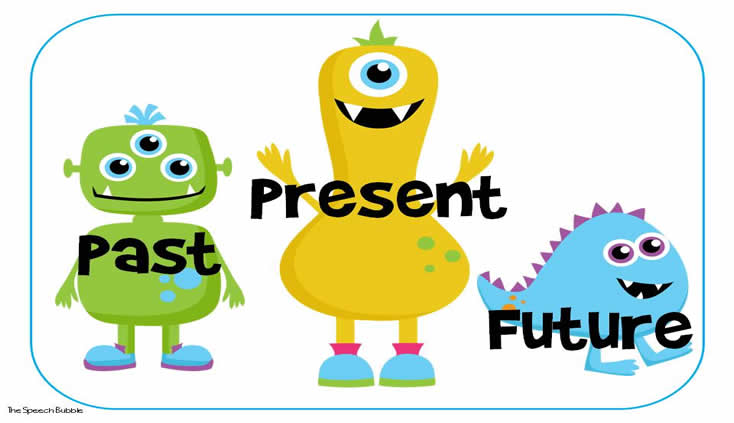Introduction (5 minutes)
- Start by showing the students the enlarged Verb Tense Chart, with past, present and future simple tense definitions, descriptions and examples.
verb-tenses-chart
- Tell students to take a moment with their partners and discuss what’s on the chart. This is meant for students to have an opportunity to make observations and discuss things that they might already know, and things they don’t.
- Have students share their observations whole class. This will help you set the stage for the objective and essential question.
- Explain that verb tense tells us when an action takes place. The past tense tells what has already happened, the present tense tells us what is happening, and the future tense tells what will happen.
- Tell students that by the end of the lesson, they will be able to identify the past, present, and future tenses, and write a sentence using a tense.
- To set the purpose for the lesson, introduce the essential question: How does knowing the past, present and future tense of verbs help us communicate? Have this on the board with the objectives. You will revisit this question at the end of the lesson when students complete the exit ticket.
Explicit Instruction/Teacher Modeling (10 minutes)
- Demonstrate how to circle and label verb tenses on the whiteboard or projector, using a simple sentence. One example is: Mrs. Strand is closing her eyes. Replace your name here to get students invested in the lesson’s content.
- Verbalize your thought process through the steps listed below, to model the objective. Write them on the board as you go, or before starting the lesson, so students can reference the steps with their partners, and independently.
- Stress that writing two additional sentences is important to meet the second objective of the lesson.
- Past-present-future-sentences
- Refer to the handout of additional sentences. The handout includes eleven sets of three sentences each, one for each verb tense. You only need to model this one set.
- Model these three sentences on the Verb Tense Assessment Handout: Mrs. Strand is closing her eyes. Mrs. Strand will close her eyes. Mrs. Strand closed her eyes.
Activity Steps
- Read a sentence.
- Circle the verb. (On this step, think aloud using the verb tense chart from the introduction of the lesson)
- Label the verb using this system: p = past, pr = present, f = future. Write the appropriate abbreviation above the circled word.
- Write two sentences that use the other two tenses. For example, Mrs. Strand will close her eyes. Mrs. Strand closed her eyes.
Guided Practice/Interactive Modeling (15 minutes)
- Pass out individual copies of the Verb Tense Chart.
- Have students follow the steps you modeled to complete 2-3 sentences on the Verb Tense Assessment handout with a partner. You know your students best. Depending on the group and level of students, you may have certain groups complete 2 sets and others 3 sets.
- After students have tried 2-3 sentences with a partner, have a pair of students join together with another pair of students to create groups of 4.
- Have the pairs compare their work, making any changes if necessary. Be sure to facilitate these discussions so that students are not off-track. Now is the time to catch any errors and decide who may need to be pulled for a small group during independent time.
- Have one group share one of their three sentences. The class must identify the verb tense used.
Independent Working Time (8 minutes)
- Ask your students to complete the rest of the Verb Tense Lesson Assessment on their own, using the steps you’ve modeled for them.
Extend
Differentiation
- Enrichment: Students that finish early will prepare a sentence to act out in front of the class. Have each student circle and label the verb. The rest of class will have to guess the verb and tense.
- Support: Give students who are struggling a copy of the Past, Present, Future Sentences handout. These students can circle and label the verb in each sentence.
Review
Assessment (5 minutes)
Independent Working time can be used as a final assessment of the skill.
- When analyzing their work, look to see if students first were able to circle and label the correct verb tense.
- Next, assess if they correctly wrote two new sentences that included different verb tenses: one present, one past, and one future sentence.
- An additional form of assessment is the exit ticket, which will be addressed in the Review and Closing.
- verb-tense-lesson-exit-ticket
Review and Closing (7 minutes)
- If time permits, allow 1-2 students to share their newly created sentence. Let the class guess the verb and the verb tense.
- Go back to the Verb Tense Chart. Ask students to turn to a partner and tell them one new thing they learned from this lesson. Make sure students speak in complete sentences.
- Review the essential question.
- Provide the exit ticket handout. The handout includes a scrambled sentence. The students must unscramble the sentence, put it in order, then circle and label the verb and tense. They must also answer the essential question in writing.
This lesson was taken from education.com


